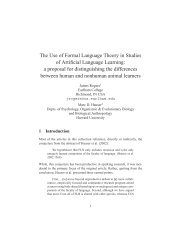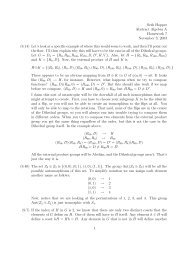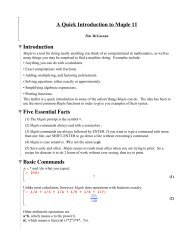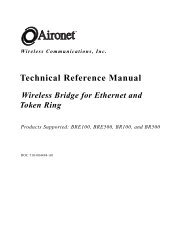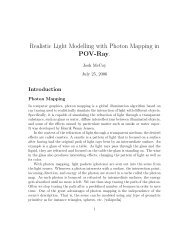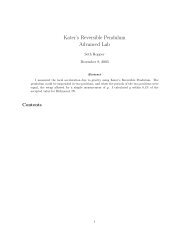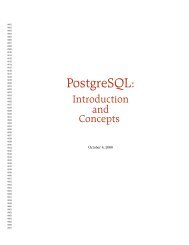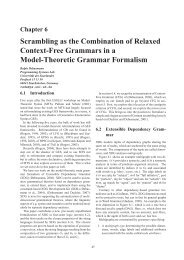Model-Theoretic Syntax at 10 - Earlham Computer Science ...
Model-Theoretic Syntax at 10 - Earlham Computer Science ...
Model-Theoretic Syntax at 10 - Earlham Computer Science ...
Create successful ePaper yourself
Turn your PDF publications into a flip-book with our unique Google optimized e-Paper software.
Edward Stabler and Edward Keenan 13<br />
m:〈every -a very gentle -a woman,NPf〉<br />
g:〈every -a,Df〉<br />
m:〈very gentle -a woman,Nf〉<br />
〈every,D〉<br />
〈-a,Agrf〉<br />
g:〈very gentle -a,Af〉<br />
〈woman,Nf〉<br />
〈very,M〉<br />
g:〈gentle -a,Af〉<br />
〈gentle,A〉<br />
〈-a,Agrf〉<br />
Figure 2.1: Span deriv<strong>at</strong>ion of an NPf<br />
even though it gives every expression a 1-step deriv<strong>at</strong>ion<br />
(Keenan and Stabler, 2003, p.58).<br />
We see in this setting th<strong>at</strong> the mere fact th<strong>at</strong> two expressions<br />
have structurally different deriv<strong>at</strong>ions does not show<br />
th<strong>at</strong> they have different structures. One and the same expression<br />
can have infinitely many deriv<strong>at</strong>ions. Even two<br />
expressions with isomorphic deriv<strong>at</strong>ions with the same<br />
c<strong>at</strong>egories, differing only in their strings, can differ in<br />
structure if the gener<strong>at</strong>ing functions can be sensitive to<br />
the strings.<br />
2.2 Balanced grammars<br />
In Span, the c<strong>at</strong>egories serve to pick out the domains<br />
of the structure building functions. Let’s say<br />
th<strong>at</strong> G = (Lex,F ) is c<strong>at</strong>egory closed iff for any<br />
s 1 ,...,s n ,t 1 ,...,t n ∈ [Lex] and for 0 < i ≤ n, if s i and t i<br />
have the same c<strong>at</strong>egories, then for all f ∈F<br />
〈s 1 ,...,s n 〉 ∈ dom( f) iff 〈t 1 ,...,t n 〉 ∈ dom( f).<br />
Let’s say th<strong>at</strong> G is c<strong>at</strong>egory functional iff for all f ∈F<br />
and for any s 1 ,...,s n ,t 1 ,...,t n ∈ dom( f), if, for 0 < i ≤ n,<br />
s i and t i have the same c<strong>at</strong>egories, then f(s 1 ,...,s n ) and<br />
f(t 1 ,...,t n ) have the same c<strong>at</strong>egory.<br />
Span is c<strong>at</strong>egory closed and c<strong>at</strong>egory functional. We<br />
will restrict <strong>at</strong>tention to grammars with these properties<br />
in the sequel except when explicitly indic<strong>at</strong>ed. Imposing<br />
these conditions requires th<strong>at</strong> syntactic c<strong>at</strong>egories be explicit<br />
in a sense, reflecting all properties relevant to the<br />
applic<strong>at</strong>ion of structure building functions.<br />
It will also be useful to require th<strong>at</strong> our grammars<br />
make their oper<strong>at</strong>ions appropri<strong>at</strong>ely explicit in the sign<strong>at</strong>ure,<br />
in a sense we now define. For any partial<br />
functionsF , let explode(F ) = {{〈a,b〉}| f i (a) =<br />
b for some f i ∈F }. And for any G = (A,F ), let<br />
explode(G) = (A,explode(F)). (The order of the functions<br />
in explode(F ) will not m<strong>at</strong>ter for present purposes.)<br />
Then for any grammar G, the grammar explode(G) defines<br />
the same language, but will often have fewer automorphisms.<br />
In explode(G), every expression th<strong>at</strong> is in<br />
the domain or range of any function is structural. So the<br />
only non-trivial automorphisms, if any, are those th<strong>at</strong> exchange<br />
lexical items not in the domain or range of any<br />
function.<br />
The grammar explode(Span) has infinitely many gener<strong>at</strong>ing<br />
functions, and is “unbalanced” in the sense th<strong>at</strong><br />
there are regularities in m and g th<strong>at</strong> we see in the automorphisms<br />
of Span, but not in automorphisms of explode(Span).<br />
Let’s say functions f,g are comp<strong>at</strong>ible iff they agree on<br />
any elements common to both of their domains; so functions<br />
with disjoint domains are always comp<strong>at</strong>ible. Since<br />
the functions g and m of Span are comp<strong>at</strong>ible, consider<br />
the grammar collapse(Span)=(Lex,〈g ∪ m〉) with a single<br />
gener<strong>at</strong>ing function. This grammar is “unbalanced” too,<br />
in the sense th<strong>at</strong> while collapse(Span) and Span have the<br />
same automorphisms, taking the union of g and m does<br />
not reveal anything new.<br />
Let’s say th<strong>at</strong> a grammar G = (A,F ) is balanced iff<br />
both<br />
• there are no two distinct, comp<strong>at</strong>ible, non-empty<br />
functions f i , f j ∈F such th<strong>at</strong> removing f i , f j and<br />
adding f i ∪ f j strictly increases the set of automorphisms,<br />
and<br />
• there are no two distinct, comp<strong>at</strong>ible, non-empty<br />
functions g,g ′ such th<strong>at</strong> g ∪ g ′ = f i for some f i ∈F ,<br />
where the result of replacing f i by g and g ′ yields a<br />
grammar with the same automorphisms as G has.<br />
Balance m<strong>at</strong>ters. As noted above, it affects the automorphisms.<br />
And it affects grammar type, the sign<strong>at</strong>ure. In<br />
the present context, balance m<strong>at</strong>ters because the elements<br />
ofF determine the available structural polynomials th<strong>at</strong><br />
are useful in comparing grammars, as explained below.<br />
In addition to the noun phrase grammar Span above,<br />
Keenan and Stabler (2003) define a “little English” Eng<br />
(p15), a “little Korean” case marking language Kor (p47),<br />
a “free word order” case marking language FWK (p54),<br />
a little verb-marking language Toba (p67), and a classical<br />
c<strong>at</strong>egorial grammar CG1 (p<strong>10</strong>5).<br />
Theorem 2.2.1. None of the grammars Span, Eng, Kor,<br />
FWK, Toba, or CG1 are balanced.<br />
Proof: It suffices to show th<strong>at</strong> in each grammar, there<br />
is a function f ∈F th<strong>at</strong> can be replaced by distinct<br />
nonempty g1,g2 such th<strong>at</strong> f = g1 ∪ g2, without changing<br />
the automorphisms. For Span, let g1 = g ∩(PH(D) ×<br />
E×E) and g2 = g ∩ (PH(A) × E×E). Then g1,g2 are<br />
comp<strong>at</strong>ible, g = g1 ∪g2, and since PH(D) and PH(A) are



